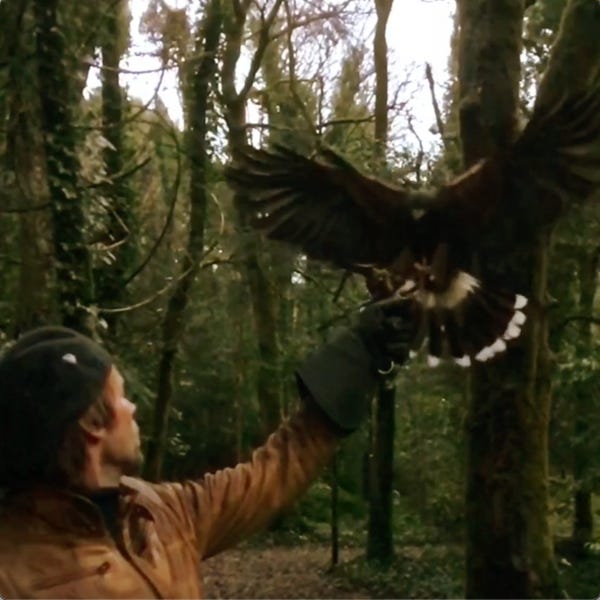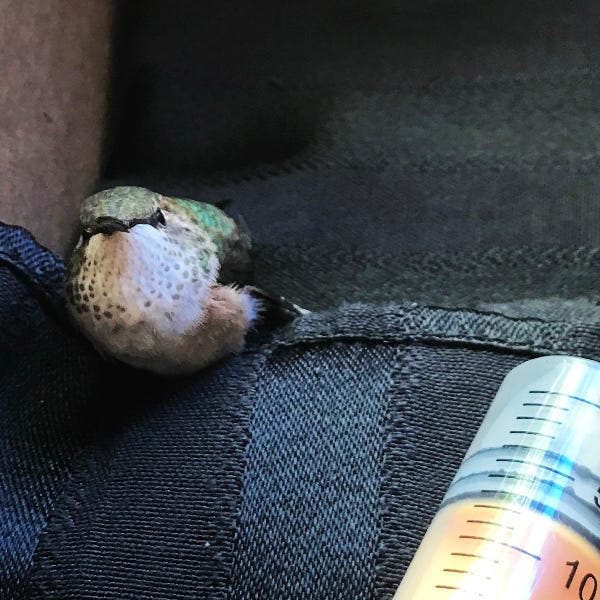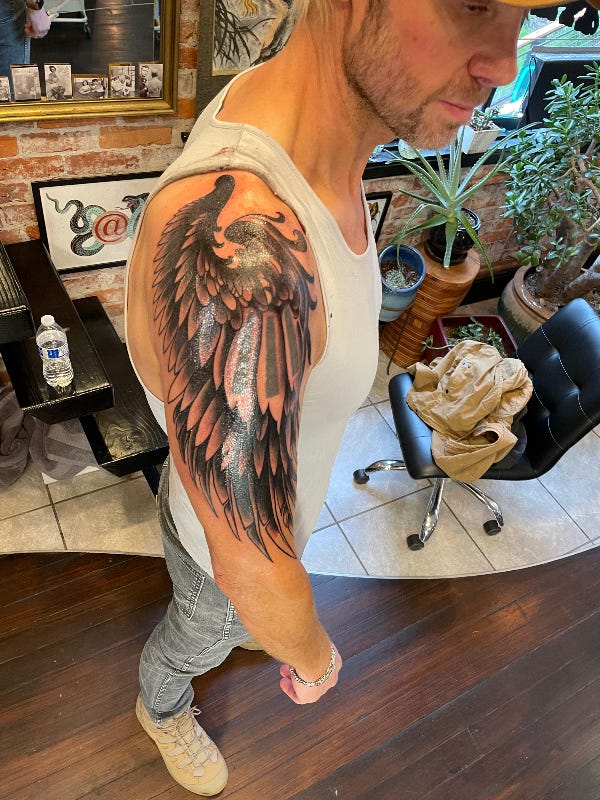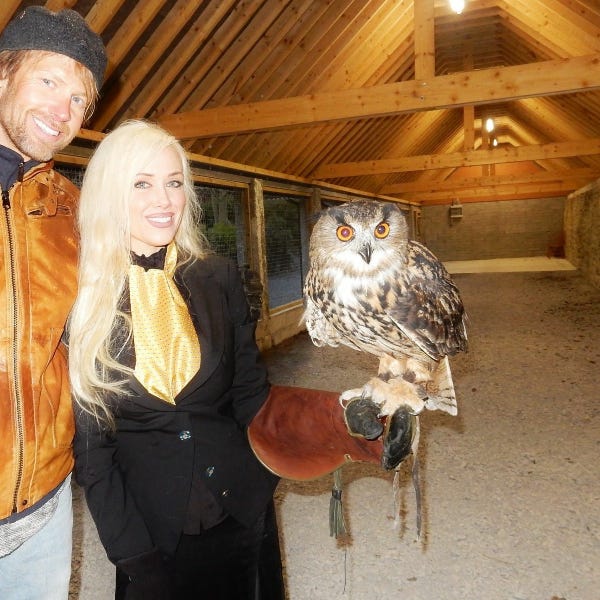There is a Balm in Gilead
A wing and a prayer.
There is a balm in Gilead To make the wounded whole; There is a balm in Gilead To heal the sin-sick soul. - From Washington Glass's 1854 hymn "The Sinner's Cure."
If I had to choose, spring would be my favorite time of year here. Everything is alive and festooned with color again, and the spirit of youth seems to shout from every flowering tree and bush. The wind blows with a particular healing freshness, as if born far out in clean seas, and frequent rain showers appear from passing clouds to wash the scene. But the biggest spring change comes on the wing.
Spring on the island is chiefly announced by flocks of robins dotting the yard after a March rain, snatching drowned worms. Then, as if emerging from the opening blossoms themselves, finches appear in our cherry tree, plucking petals and dropping them on the lawn like snow. Soon we see flycatchers and wrens, sparrows and jays, warblers and chickadees, all fluttering about and carrying on their mysterious business with much fanfare and song, attracting mates, competing for prime nesting sites, washing in our birdbaths, and generally appearing to enjoy just being alive.
Flickers wake us at dawn by pecking at the chimney weatherhead, and the soft whoooo whoooo of mourning doves drifts in from the garden. A morning walk through the forest is met with the hammering of pileated woodpeckers on hemlock snags and the tapping of red-breasted sapsuckers turning our Oregon ash and Himalayan birch into pegboards. In the afternoons, swallows dart above the cliff edge, twittering as they catch bugs and play in the updraft, while northern harriers and red-tailed hawks screech from on high with their avian minds and keen eyes on our multiplying rabbits. California quail announce Chi-ca-go, before emerging from the salal and pattering across the grass followed by a brood of tiny hatchlings tripping over their own feet, and when the evening marine fog rolls in, barred owls can be heard calling hoo hoo hoooooo from the misty trees. It’s all a very beautiful and noisy prayer.
In spring more mortal singers than belong To any one place cover us with song. Thrush, bluebird, blackbird, sparrow, and robin throng... - From the Robert Frost poem “Our Singing Strength.”
If you ever want some fun light reading, do a web search for the collective nouns for birds. (Or better yet, read A Charm of Goldfinches and Other Wild Gatherings by Matt Sewell.) They’re astounding and provide a lovely glimpse into the character of the species being named and of the one that named them. Here are a few of my favorites:
A mischief of magpies.
A quarrel of sparrows.
A parliament of rooks.
An unkindness of ravens.
Spring does bring a few annoyances, of course. Allergies to name one. The creeping weeds for another. But what really dims the season’s color for us are the constant bird strikes on our windows. This house is made mostly of glass, which is lovely for the views, but when the sun wraps around the western walls, the windows become mirrors that tempt our feathered friends with a false twin of every tree, bush, and shrub. The thud of them hitting the panes is heart-wrenching, and my wife and I rush to the window as if our hope alone might help their plight. Sometimes they’re stunned and need only time to recover and fly away, perhaps a bit wiser; but other times they lay dead, still beautiful but now broken and wrecked, their song silenced in an instant, and there’s nothing to be done except to scoop them up and say a little prayer as I send them sailing for one final flight over the cliff and into the surf far below. These sky burials happen far too often for me.
At times we unintentionally add to the suffering. Last spring, my wife purchased a crow statue to sit atop our fountain after the shopkeeper told her its name was Charlie (her uncle Charlie had passed away the week before), and Charlie wasn’t here a full day when a sharp-shinned hawk dropped from the sky in a full attack dive and broke its leg and maybe a wing when it hit cast-stone instead of feathers. I chased the hopping hawk around for an hour trying to catch it with welding gloves, so I could deliver it to a raptor rescue, but it eluded me. Last summer a young Anna’s hummingbird injured its wing on the glass that surrounds our deck, turning a quiet afternoon reading in the sun into a four-hour round-trip (feeding the grumpy little fellow sugar water from a syringe at stoplights) to the saints at Sarvey Wildlife Care Center, where it was lovingly nursed back to health. A happy ending, but small consolation when tossing so many of these broken angels over the cliff.
I’ve tried everything I can think of, short of shutters – raptor stickers, masking tape, plastic owls on the eves – but nothing seems to deter these collisions. To make matters worse, we have a very smart merlin that has figured out it can chase songbirds toward the glass, peel away at the last moment, and then return and snatch the stunned prey from the ground. Our neighbors inform us that this merlin does the same thing at their place, and, needless to say, it is a very well-fed neighborhood falcon. If any of you have ideas, I’d love to hear them.
I sometimes get to see birds from a unique vantage. Paragliding on the coastal bluffs here, I often soar alongside eagles, hawks, and ravens, and on rare occasions, peregrine falcons or osprey too. Most of us who fly take on a spirit animal, depending on our flying style and which birds choose to come out and play with us. I have a red-tailed hawk that soars with me, sometimes flying beside me, other times leading me to the best lift. It’s amazing to watch the intricate movements of its tail and primary feathers that allow it to hover in place in strong and gusty winds, instinctually doing by rote what takes so much mental effort from me. On a recent visit to Port Townsend, I commemorated my spirit animal with a stylized wing on my arm.
When my wife and I visited Ireland, we took a falconry course and flew Harris’s hawks in the forests surrounding Lough Corrib. It’s an amazing feeling seeing these majestic creatures glide nimbly through the trees and return to your arm at the sound of a bell. With a 300-million-year gap between ourselves and any common ancestor, looking into the eyes of these raptors is like a window into vanished time. Interestingly, Harris’s hawks were originally brought to Ireland all the way from Arizona, being uniquely social among raptors, and thus especially adaptable to falconry.
My wife got to fly a great horned owl named Dingle (Dingle dislikes men) that was so large it dragged her to the ground in a tumble of hair and feathers and mouse entrails. Dingle was unharmed but clearly embarrassed. I was surprised to learn that owls are extremely farsighted, rendering them nearly blind up close, and they use the feathers on their talons and bristles around their beaks to feel their prey. If you ever get a chance to fly a hawk or falcon or owl, you should. It’s a wonderful experience. Someday I hope to travel to Mongolia to see the Kazakhs hunt with golden eagles.
Wherever you are, I hope there are birds in your life, and that you take time to enjoy them. It’s been a tough couple of years, and we all deserve to spread our wings a bit and celebrate the return of spring. Wishing you all blue skies and tailwinds.
An audio recording of this essay can be found here:







Due to a stroke causing mobility problems, my nature friends are an important part of my world. They don't even fly away when I put seed out through the window. This year I even have three types of woodpeckers! My favorite is the Downey woodpecker.
Spring is my favorite time of year also. The robins have returned. One nested on our porch last year and looks like she's returning this year. If you find something that works to keep the birds from flying into your window, please share. I have the same problem.